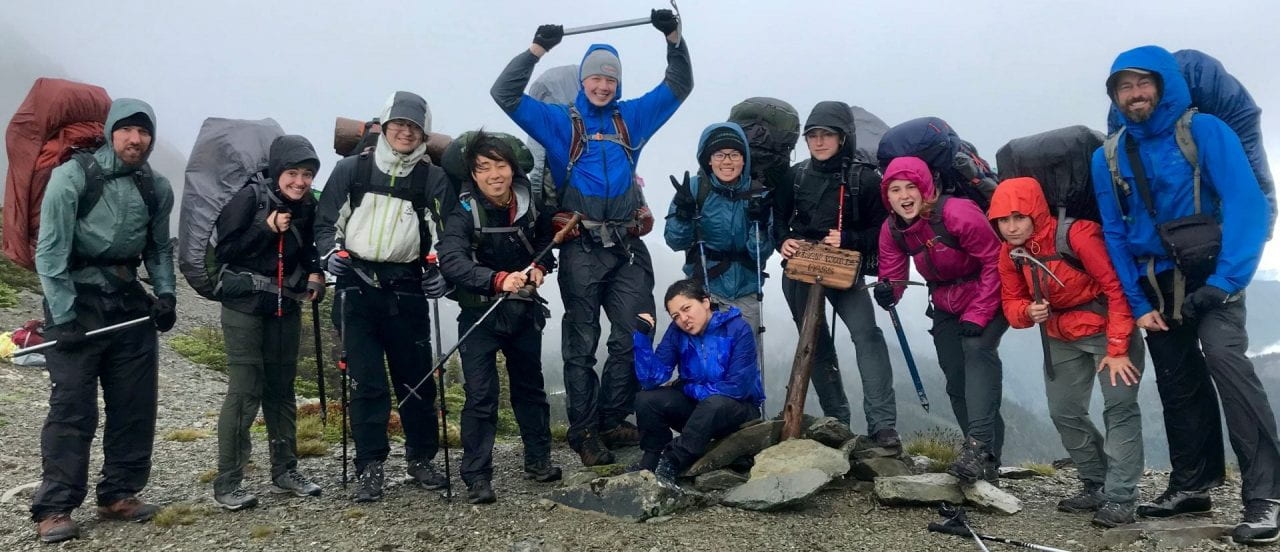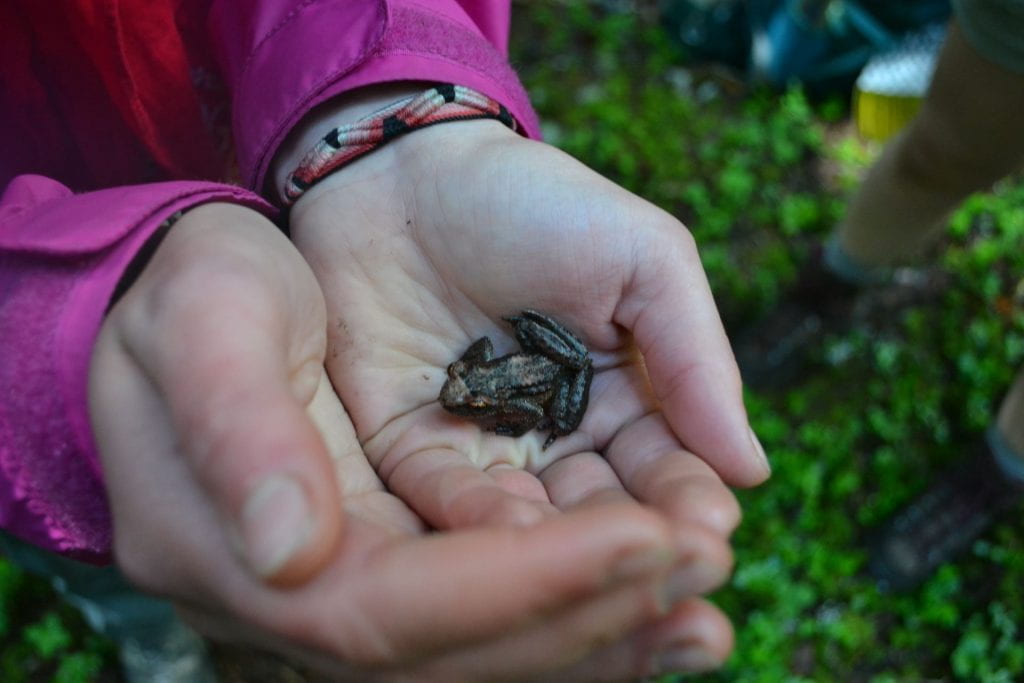I am slowly growing accustomed to this rhythm of life. Brush teeth, fetch water, cook oatmeal, blow nose with a leaf, then stow away the tent. I am starting to get more familiar with where my things are stored in my pack that houses a gazillion zippers and secret pockets. Re-packing everything into my backpack is like playing Tetris (wilderness-mode) because I try to fit each item into the right spaces. Diana is the best tent buddy, ever! She packs up at a crazy speed and is always ready-to-go. My favorite vegan cook group (shout out to Zhewen and Hanna!) happens to be the group that sleeps in the most, so I do my best to get myself ready as efficiently as possible with the remaining time.
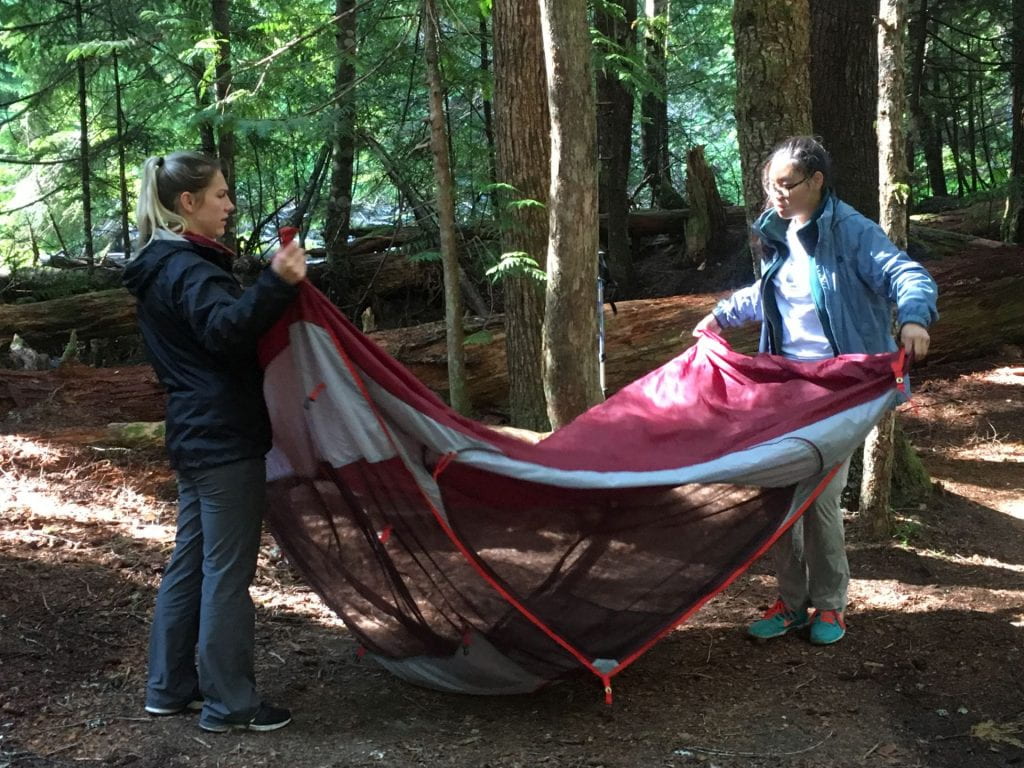
Diana and Amy folding up their tent and getting their bags ready for the hike. This tent sheltered two people. Photography by Zachariah Fincher.
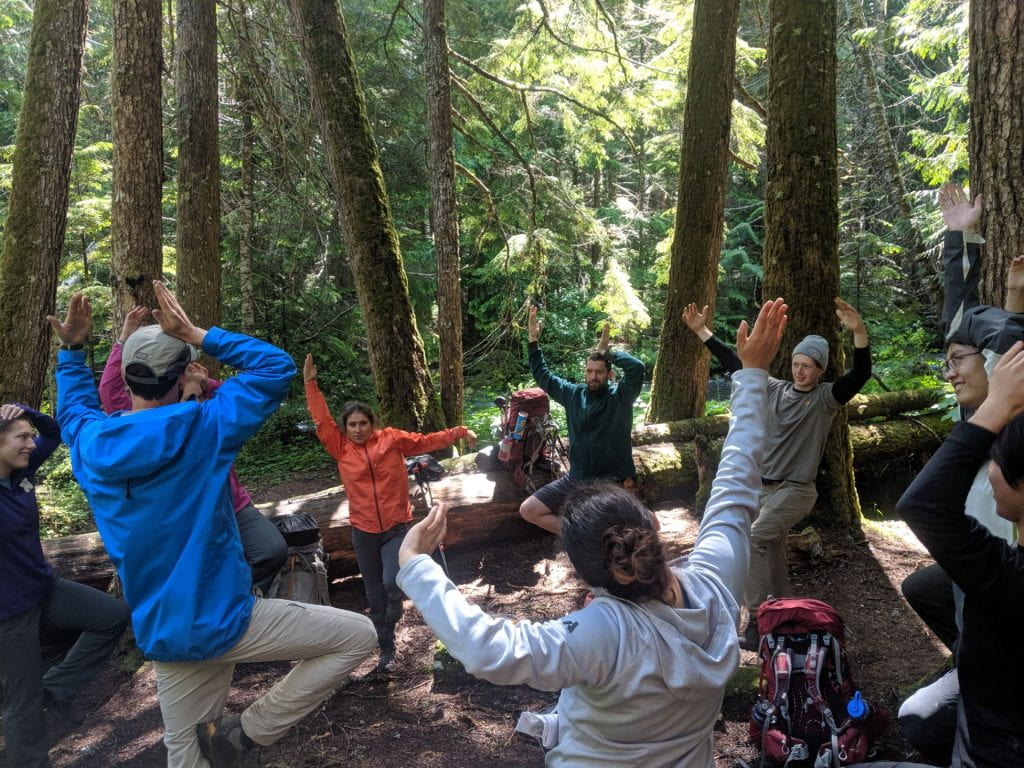
Group did some pre-hike yoga stretches, with poses representing different species of trees in the forest around us. We got a good laugh but also stretched our limbs quite a bit. Not pictured: Tim and Katie K. giggling at how ridiculous we looked with our yoga poses. Photography by Katie Keil.
We started our day with a quote and a quick yoga stretch, led by “Bird-bath” Tim. Still standing in a circle, we discussed how to identify different plant species. Jonathan, as instructed by Tim, presented the leaves and lichens he gathered from the area: Dragon skin lichen – Lobaria pulmonaria (a Nitrogen fixer), Silver Fir – Abies alba, and Western redcedar – Thuja plicata. It was a warm but breezy day filled with Varied Thrush (Ixoreus naevius) singing in harmony with itself. About 1 mile into the old growth forest, we paused our hike and dropped our bags aside. It was time to journal in solitude. We are all passionate about hiking, but there is great value in stopping where we are and appreciating our surroundings instead of constantly getting crazy miles in. We took this time to reflect our experience in the wilderness thus far, and what wisdom we might glean from these centuries-old trees. In the dense forest, sunrays seeped through the gaps and laid a shadow on my notebook. The shadow outlined a Western Redcedar leaf. I could hear the stream water rolling in the distance and the superficial roar of the airplane that was passing by ahead. I reflected on the simplicity in the forest in contrast to the complexity of urban life back home. Back home, there is constant stress involving job security, social anxiety, and school. In the forest, trees grow as much as they can, and if other trees surpass them, they are out-competed and accept it. How do these two seemingly different entities, civilization and forest, exist together at peace? I wrote a haiku to reflect my thoughts:
A varied thrush sings
As I ponder to myself
Humans and nature
Can live harmoniously
Like varied thrush sings?

Everyone chose their own spot (or tree for companion) during this 20-minute period of solitude and quiet reflection. Photography by Katie Keil.
It was time to continue our hike towards Falls Camp, when Autumn announced that she lost her notebook. In the spirit of a team, everyone willingly traced her steps and searched for the lost notebook. Good news, she found it! Soon after rejoining the group, Katie or Jonathan found a rare tailed frog along the trail. It looked like a Coastal Tailed Frog.
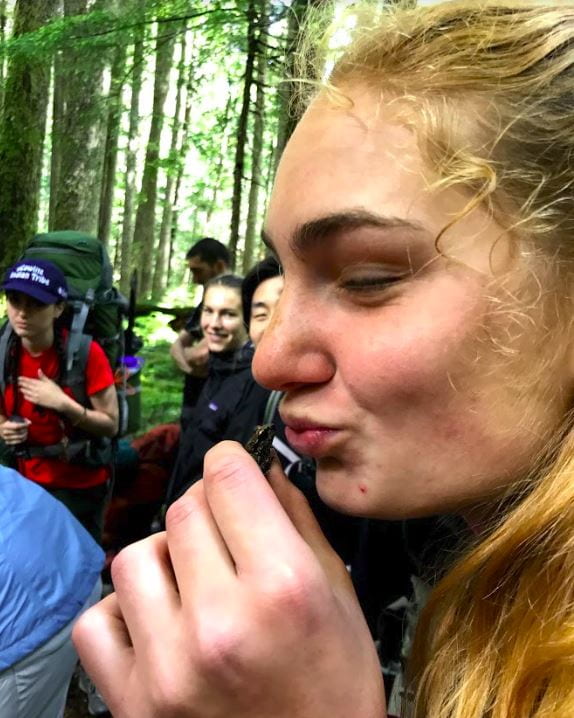
Katie smooches the tailed frog in hopes of turning it into a prince. *spoiler alert: the frog remained a frog. Photography by Hanna Lester.
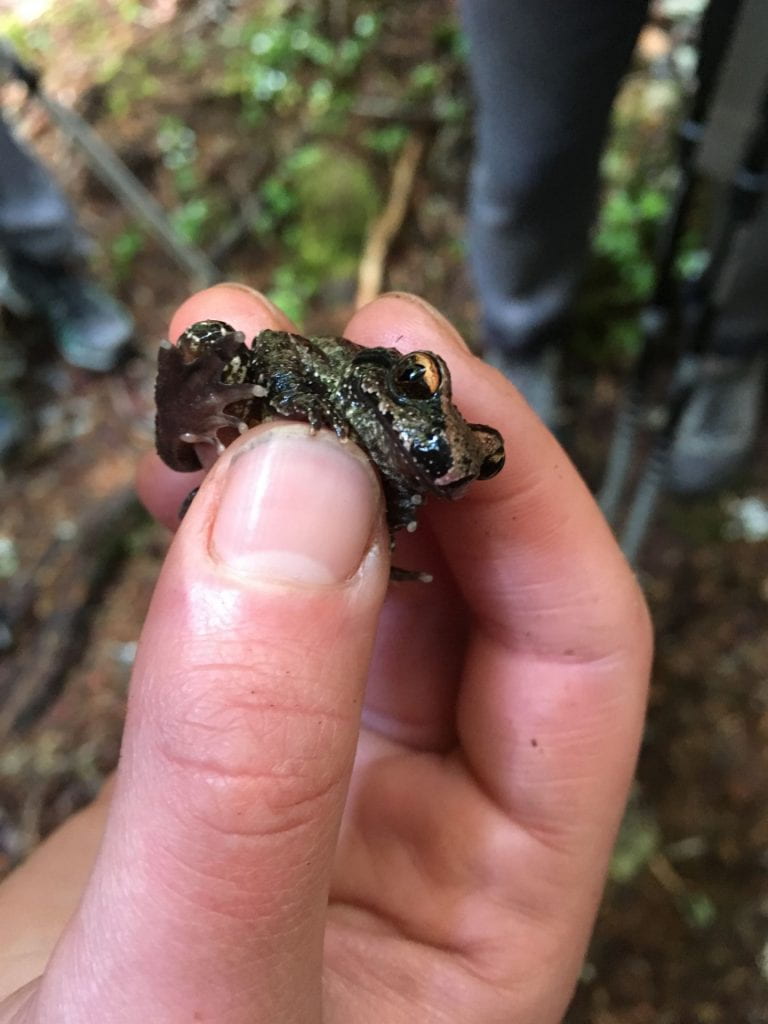
Tailed Frog. The tail is a copulatory organ. These frogs have internal fertilization otherwise their spawn would be washed away in the swift streams where they breed. Tadpoles suck onto rocks with sucker mouths to survive in the streams. Photography by Zachariah Fincher.
Yellow-tipped Coral Fungus (Ramaria formosa). Its coral shape is composed of pinkish branched parts. Eating this will make you feel sick. Photography by Tim Billo.
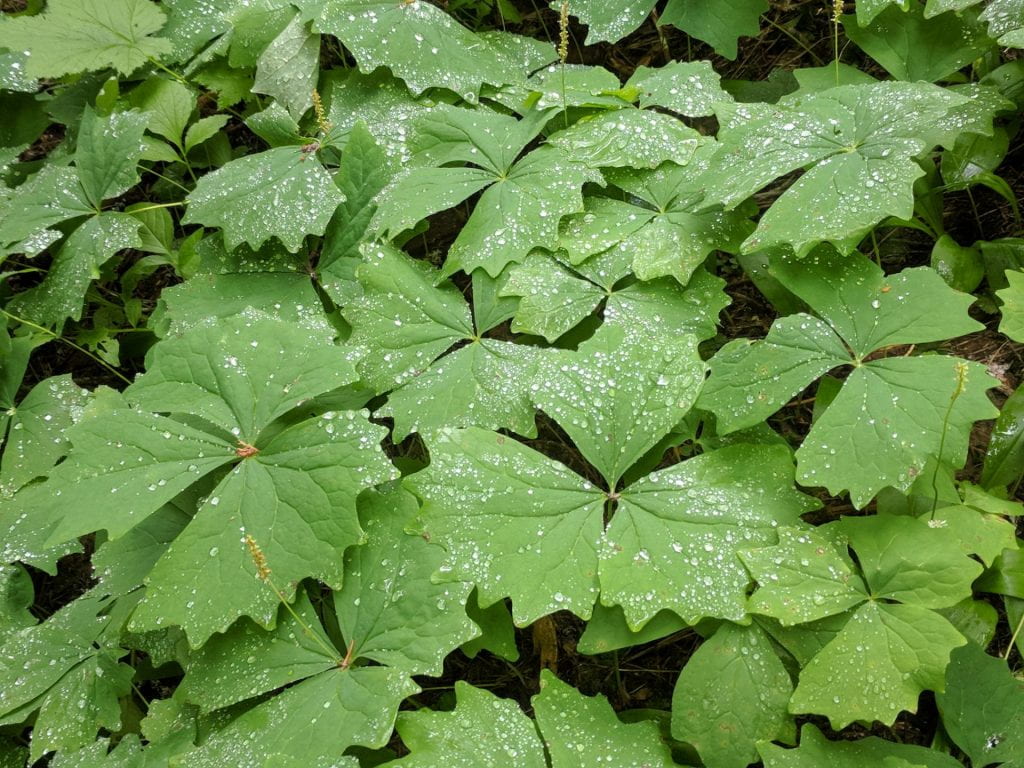
Vanilla Leaf (Achlys triphylla). Easily, the best natural tissue paper to use in the wilderness. Soft on the nose, highly recommend. Photography by Tim Billo.
At Falls Camp, we set up our tents and prepared supper. The dip-a-day crew hopped into the cold river nearby for a quick ice bath. Note that this is where Tim’s “Bird-bath” trail name was born. After dinner, Aisling and Hanna held their discussions. Aisling covered conceptions of wilderness in the modern day and ways in which this conception may be outdated and exclusive. We discussed ways in which wilderness and natural spaces are or could be involved in the human civilization equally, like National Park versus the city park. Hanna discussed how consumption and economic growth may impact wilderness. From the variety of questions raised, I could tell that both discussions led us to think deeply about what wilderness should be like and how our lives can be intertwined with it (or not be).

Everyone huddling by the campfire to dry our wet clothing and participate in Hanna’s discussion on the impact of consumption and economic growth on national parks. Photography by Tim Billo.
Challenges to National Parks:
Climate change is real and reshaping the regularities on Earth as quickly as ever. Humans are the catalysts to climate change. A series of events may occur: overpopulation, worldwide hunger, lack of agricultural land, then expansion into preserved parks. In the next century, national parks would still be facing controversial issues like whether lands should be “left untrammeled” or resourced to its maximum efficiency to support the economy and better people’s lives (in the short run). Also, the issue of global financial disparity will draw audiences to national parks apart. With the current laws in place, the audience gap is only getting wider and wider where the parks are reserved for only the wealthy. But there is hope at the end of the tunnel. Environmental educational programs and supportive governments may help increase awareness of the importance of nature’s role in our past, present, and future generations. That may help preserve national parks. But who knows, perhaps parks may not even exist because Eco-Topia may takeover the world and more peacefully(?) integrate natural areas into civilization.
Overall Reflection:
Despite the fresh blisters, bug bites, sore neck, and bruises, hiking in the backcountry was absolutely refreshing. Although I hiked alongside 12 other people, this 9-day trip was my period of solitude. It was a brief pause from the honking and clanging of urban life ordeals. I had headspace to appreciate and feel my surroundings with all my senses. What mattered in the moment was to survive. The entire time I was hiking, I had the chorus from Adele’s song on replay in my mind: “Should I give up, or should I just keep chasing pavements”. The UW classes I took with Tim were taught in natural areas on or near campus. Then, that was the extent of what I understood as “learning outside of the classroom”. But wow, I was naive. The amount of physical and mental effort I put into this past week was overwhelming. Never have I ever been backpacking. I felt uncomfortable being out in the wilderness and outside the comforts of my apartment. I literally voluntarily signed up to be uncomfortable. Not only did I have to be physically strong, but also mentally capable to keep pushing forward to survive. Without self-motivation and overflowing support from my team, my success would have been doubtful.
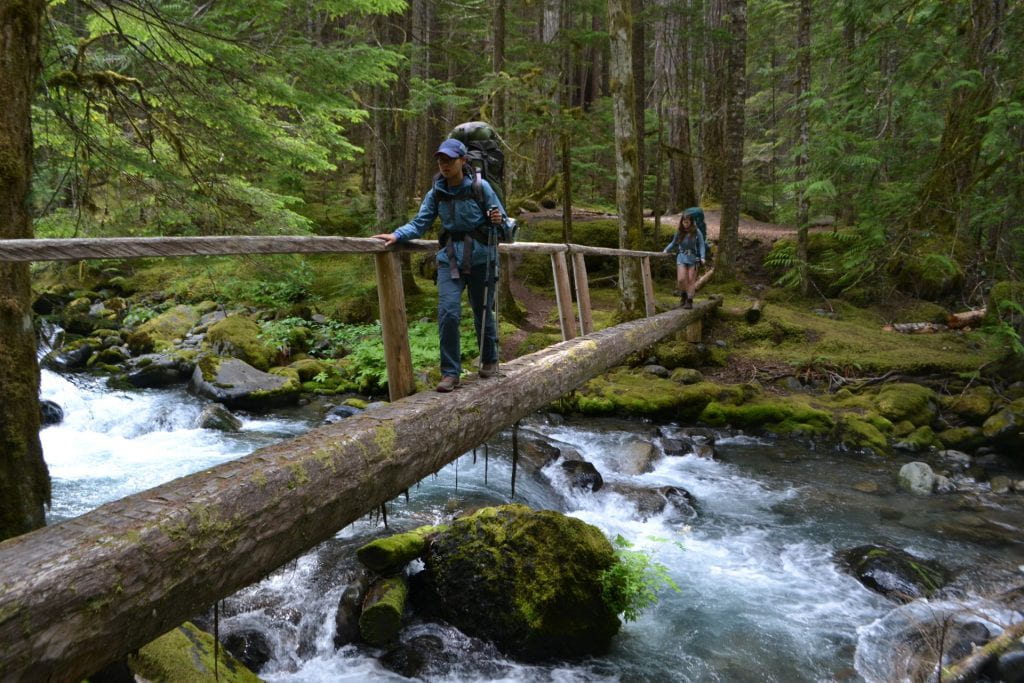
Amy crossing the bridge that allows passage through the stream. Just one of the many obstacles during the hikes. Photography by Tim Billo.
I gained different perspectives from the discussions we had each night. People from different backgrounds voiced their thoughts into the safe circle we created. Having lived in the outdoors (a stark contrast to my life in Seattle) for a few days, I learned that keeping parts of the wilderness in the Anthropocene as “untrammeled” as possible teaches us the value of humility. There is that humbling feeling when you are brushing your teeth while looking out into the grand alpine mountains. Humans are truly fragile against the powers of nature. Tim constantly reinforced this idea throughout the hikes. Tim led us on trails that appeared quite frightening and deathly-impossible to cross. One fall probably was not going to kill any of us, but it was thanks to these feelings of unease and the overcoming of that uneasiness that I learned to have more faith in myself. “Trust your feet”, Tim would remind us when crossing difficult paths. I feel like this faith in oneself can be applied to not only our lives in the wilderness, but also our lives in the city.
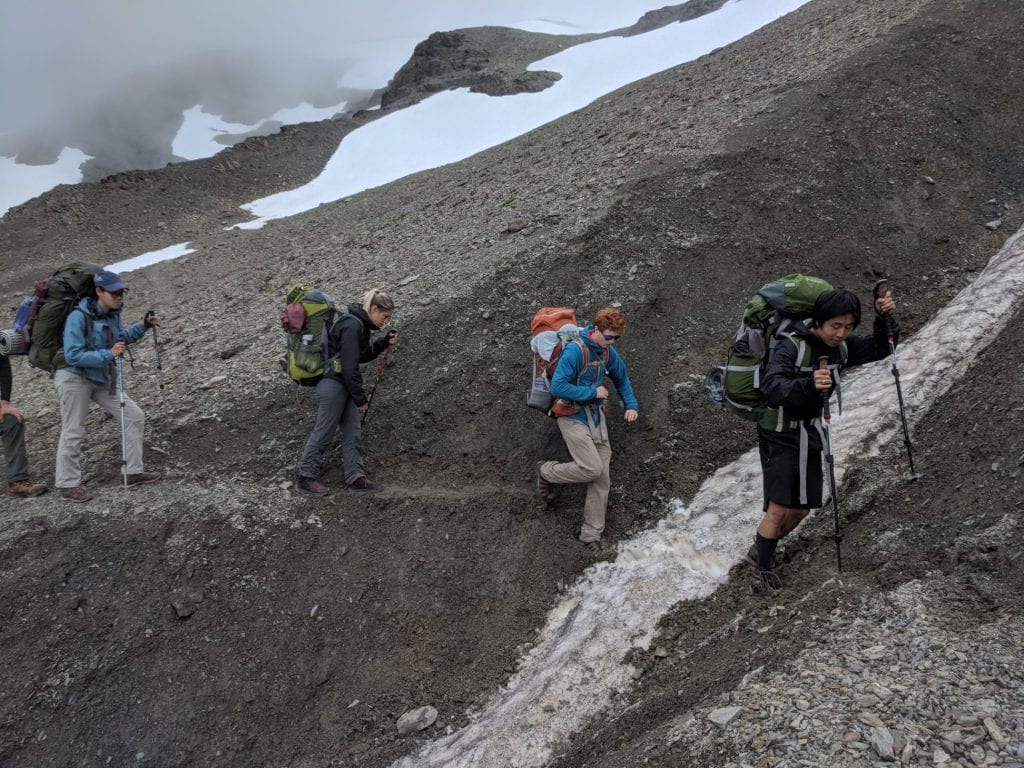
From left to right: Amy, Diana, Zachariah, Jonathan. Students using a trail carved out by Tim. This part was really scary because it was a new path carved out by Tim himself using an ice axe, so it was not as established. But it felt good to have gone over a not-so-sturdy path without any injuries. Photography by Tim Billo.
Towards the last stretch of the trip towards obstruction point, my eyes watered. Looking ahead, vans were parked neatly atop the hill. Looking back, snowy mountains and evergreen trees filled my visual frame. At that point, I finally understood the main reason I wanted to go on this trip. The reason was not that I had extra summertime to spare, but rather, to challenge myself – both body and soul – to complete a task I had never undertaken before. My completion of the trip proved to myself that I am more capable than I think I am. I am capable. I am strong. I can achieve results if I set my heart to it. This is a valuable lesson that no classroom experience can ever teach.
